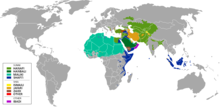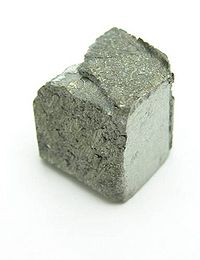Petro-Islam usually refers to the extremist and fundamentalist interpretation of Sunni Islam—sometimes called "Wahhabism"—favored by the conservative oil-exporting Kingdom of Saudi Arabia. Its name derives from source of the funding—petroleum exports—that spread it through the Muslim world following the Yom Kippur War. The term is sometimes called "pejorative" or a "nickname".
According to Sandra Mackey the term was coined by Fouad Ajami. It has been used by French political scientist Gilles Kepel, Bangladeshi religious scholar Imtiyaz Ahmed, and Egyptian philosopher Fouad Zakariyya, among others.
Usage and definitions
The
use of the term to refer to "Wahhabism" (the dominant interpretation of
Islam in Saudi Arabia) is widespread but not universal. Variations on,
or different uses of, the term include:
- Use of resources by Saudi Arabia "to project itself as a major player in the Muslim world". The distribution of large sums of money from public and private sources in Saudi Arabia to advance Wahhabi doctrines and pursue the Saudi Arabian foreign policy.
- Attempts by the Saudi rulers to use both Islam and its wealth to win the loyalty of the Muslim world.
- Diplomatic, political and economic—as well as religious—policies promoted by Saudi Arabia.
- The type of Islam favored by petroleum-exporting Muslim-majority countries, particularly the other Gulf monarchies (United Arab Emirates, Kuwait, Qatar, etc.)—not just Saudi Arabia.
- A "hugely successful" enterprise made up of a "colossal ensemble" of media and other cultural organs that has broken the "secularist and nationalist" monopoly of the state on culture, media and, "to a lesser extent", education; and is supported by both Islamists and socially conservative business "elements", who opposed the Arab nationalist ideologies of Nasserism and Baathism.
- More conservative Islamic cultural practices (separation of the sexes, hijab or more complete hijab) brought back (to Egypt) from Gulf oil states by migrant workers.
- A term used by secularists, particularly in Egypt, to refer to efforts to require the enforcement of sharia (Islamic law).
- Islamic interpretation that is "anti-woman, anti-intellectual, anti-progress, and anti-science ... largely funded by the Saudis and Kuwaitis".
Background
Petroleum
products revenue in billions of dollars per annum for five major Muslim
petroleum exporting countries. Saudi Arabian production
Years were chosen to shown revenue for before (1973) and after (1974) the October 1973 War, after the Iranian Revolution (1980), and during the market turnaround in 1986. Iran and Iraq are excluded because their revenue fluctuated due to the revolution and the war between them.
One scholar who spelled out the idea of petro-Islam in some detail is Gilles Kepel.
According to Kepel, prior to the 1973 oil embargo, religion throughout
the Muslim world was "dominated by national or local traditions rooted
in the piety of the common people." Clerics looked to their different
schools of fiqh (the four Sunni Madhhabs: Hanafi in the Turkish zones of South Asia, Maliki in Africa, Shafi'i in Southeast Asia, plus Shi'a Ja'fari, and "held Saudi inspired puritanism" (using another school of fiqh, Hanbali) in "great suspicion on account of its sectarian character," according to Gilles Kepel.
While the 1973 War (also called the Yom Kippur War) was started
by Egypt and Syria to take back land won by Israel in 1967, the "real
victors" of the war were the Arab "oil-exporting countries", (according
to Gilles Kepel), whose embargo against Israel's western allies stopped Israel's counter offensive.
The embargo's political success enhanced the prestige of the
embargo-ers and the reduction in the global supply of oil sent oil
prices soaring (from US$3 per barrel to nearly $12)
and with them, oil exporter revenues. This put Muslim oil exporting
states in a "clear position of dominance within the Muslim world". The
most dominant was Saudi Arabia, the largest exporter by far (see bar
chart).
Saudi Arabians viewed their oil wealth not as an accident of
geology or history, but connected to religion—a blessing by God of them,
to "be solemnly acknowledged and lived up to" with pious behavior.
With its new wealth the rulers of Saudi Arabia sought to replace
nationalist movements in the Muslim world with Islam, to bring Islam "to
the forefront of the international scene", and to unify Islam
worldwide under the "single creed" of Wahhabism, paying particular
attention to Muslims who had immigrated to the West (a "special
target")."
Influence of "Petro-dollars"
According to scholar Gilles Kepel, (who devoted a chapter of his book Jihad to the subject -- "Building Petro-Islam on the Ruins of Arab Nationalism"), in the years immediately after the 1973 War,
`petro-Islam` was a "sort of nickname" for a "constituency" of Wahhabi
preachers and Muslim intellectuals who promoted "strict implementation
of the sharia [Islamic law] in the political, moral and cultural spheres".
In the coming decades, Saudi Arabia's interpretation of Islam became influential (according to Kepel) through
- the spread of Wahhabi religious doctrines via Saudi charities; an
- increased migration of Muslims to work in Saudi Arabia and other Persian Gulf states; and
- a shift in the balance of power among Muslim states toward the oil-producing countries.
Author Sandra Mackey describes the use of petrodollars on facilities for the hajj—for
example leveling hill peaks to make room for tents, providing
electricity for tents and cooling pilgrims with ice and air
conditioning—as part of "Petro-Islam", which she describes as a way of
building the Muslim faithful's loyalty toward the Saudi government.
Religious funding
The Saudi ministry for religious affairs printed and distributed millions of Qurans
free of charge, along with doctrinal texts that followed the Wahhabi
interpretation. In mosques throughout the world "from the African plains
to the rice paddies of Indonesia and the Muslim immigrant high-rise
housing projects of European cities, the same books could be found",
paid for by Saudi Arabian government.
Imtiyaz Ahmed, a religious scholar and professor of International Relations at University of Dhaka
sees changes in religious practices in Bangladesh as linked to Saudi
Arabia's efforts to promote Wahhabism through the financial help it
provides countries like Bangladesh. The Mawlid,
the celebration of the Prophet Muhammad’s birthday and formerly "an
integral part of Bangladeshi culture" is no longer popular, while black
burqas for women are much more so.
The discount on the price of oil imports Bangladesh receives doesn't
"come free", according to Ahmed. "Saudi Arabia is giving oil, Saudi
Arabia would definitely want that some of their ideas to come with oil."
Mosques
Pakistan's Faisal Mosque, a gift from Saudi Arabia's King Faisal
More than 1,500 mosques were built around the world from 1975 to 2000 paid for by Saudi public funds.
The Saudi-headquartered and financed Muslim World League
played a pioneering role in supporting Islamic associations, mosques,
and investment plans for the future. It opened offices in "every area of
the world where Muslims lived."
The process of financing mosques usually involved presenting a local
office of the Muslim World League with evidence of the need for a
mosque/Islamic center to obtain the offices 'recommendation' (tazkiya) to "a generous donor within the kingdom or one of the emirates".
Saudi-financed mosques were generally built using marble
'international style' design and green neon lighting, in a break with
most local Islamic architectural traditions, but following Wahhabi ones.
Islamic banking
One mechanism for the redistribution of (some) oil revenues from
Saudi Arabia and other Muslim oil-exporters, to the poorer Muslim
nations of African and Asia, was the Islamic Development Bank. Headquartered in Saudi Arabia, it opened for business in 1975. Its lenders and borrowers were member states of Organisation of the Islamic Conference (OIC) and it strengthened "Islamic cohesion" between them.
Saudi Arabians also helped establish Islamic banks with private investors and depositors. DMI (Dar al-Mal al-Islami: the House of Islamic Finance), founded in 1981 by Prince Mohammed bin Faisal Al Saud, and the Al Baraka group, established in 1982 by Sheik Saleh Abdullah Kamel (a Saudi billionaire), were both transnational holding companies.
Migration
By 1975, over one million workers—from unskilled country people to experienced professors from Sudan, Pakistan, India, Southeast Asia, Egypt, Palestine, Lebanon, and Syria—had moved the Saudi Arabia and the Persian Gulf
states to work and returned after a few years with savings. A majority
of these workers were Arab and most were Muslim. Ten years later the
number had increased to 5.15 million and Arabs were no longer in the
majority. 43% (mostly Muslims) came from the South Asia. In one country, Pakistan, in a single year, (1983),
"the money sent home by Gulf emigrants amounted to $3 billion, compared with a total of $735 million given to the nation in foreign aid. .... The underpaid petty functionary of yore could now drive back to his hometown at the wheel of a foreign car, build himself a house in a residential suburb, and settle down to invest his savings or engage in trade.... he owed nothing to his home state, where he could never have earned enough to afford such luxuries."
Muslims who had moved to Saudi Arabia, or other "oil-rich monarchies
of the peninsula" to work, often returned to their poor home country
following religious practice more intensely, particularly practices of
Wahhabi Muslims.
Having "grown rich in this Wahhabi milieu" it was not surprising that
the returning Muslims believed there was a connection between that
milieu and "their material prosperity", and that on return they followed
religious practices more intensely and that those practices followed
Wahhabi tenants.
Kepel gives examples of migrant workers returning home with new
affluence, asking to be addressed by servants as "hajja" rather than
"Madame" (the old bourgeois custom).
Another imitation of Saudi Arabia adopted by affluent migrant workers
was increased segregation of the sexes, including shopping areas.
State leadership
In the 1950s and 1960s Gamal Abdul-Nasser,
the leading exponent of Arab nationalism and the president of the Arab
world's largest country had great prestige and popularity.
However, in 1967 Nasser led the Six-Day War against Israel which ended not in the elimination of Israel but in the decisive defeat of the Arab forces
and loss of a substantial chunk of Egyptian territory. This defeat,
combined with the economic stagnation from which Egypt suffered, were
contrasted with the perceived victory of the October 1973 war whose pious battle cry of Allahu Akbar replaced `Land! Sea! Air!` slogan of the 1967 war, and with the enormous wealth of the resolutely non-nationalist Saudi Arabia.
This changed "the balance of power among Muslim states" toward
Saudi Arabia and other oil-exporting countries. gaining as Egypt lost
influence. The oil-exporters emphasized "religious commonality" among
Arabs, Turks, Africans, and Asians, and downplayed "differences of
language, ethnicity, and nationality." The Organisation of Islamic Cooperation—whose permanent Secretariat is located in Jeddah in Western Saudi Arabia—was founded after the 1967 war.
Criticism
At least one observer—The New Yorker magazine's investigative journalist Seymour Hersh—has suggested that petro-Islam is being spread by those whose motivations are less than earnest/pious. Petro-Islam funding following the Gulf War, according to Hersh, "amounts to protection money" from the Saudi regime "to fundamentalist groups that wish to overthrow it."
Egyptian existentialist Fouad Zakariyya
has accused purveyors of Petro-Islam as having as their objective the
protection of the oil wealth and "social relations" of the "tribal
societies that possess the lion's share of this wealth", at the expense
of the long term development of the region and the majority of its
people.
He further states that it is a "brand of Islam" that bills itself as
"pure" but rather than being the Islam of the early Muslims has "never"
been "seen before in history".
Authors who criticize the "thesis" of Petro-Islam itself—that
petrodollars have had a significant effect on Muslim beliefs and
practices—include Joel Beinin and Joe Stork. They argue that in Egypt,
Sudan and Jordan, "Islamic movements have demonstrated a high level of
autonomy from their original patrons." The strength and growth of Muslim Brotherhood,
and other forces of conservative political Islam in Egypt can be
explained (Beinin and Stork believe), by internal forces—the historical
strength of the Muslim Brotherhood, sympathy for the "martyred" Sayyid Qutb, anger with the "autocratic tendencies" and failed promises of prosperity of the Sadat government.













